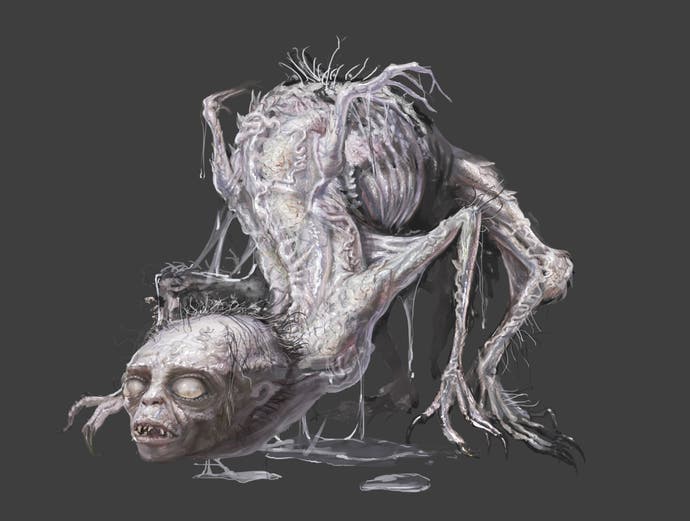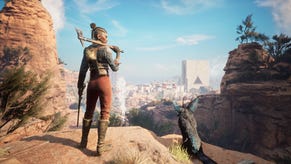Dark Souls 3 and the meaning of 'utsukushi'
There's something about his game that Hidetaka Miyazaki isn't sure even its makers fully understand.
In a church in Hamburg, the pews have been rearranged and dozens of consoles have been lined up wall-to-wall. A makeshift stage has all but engulfed the altar, drinks are being served at the sidelines and when we first arrive, bleary-eyed from an early plane journey, organ music blares down from above as dry ice is pumped in from the sidelines. The very small part of my brain that identifies as a former Irish Catholic is thrilled and ever-so-slightly aghast at the blasphemy of it all, but for today, the congregation that has gathered for worship here are all pious members of the church of Dark Souls.
After a presentation and several hours of play, during which I've almost definitely assumed the wild-eyed thousand-yard stare my face reserves especially for From Software games, a Bandai Namco PR taps me on the shoulder and leads me to a narrow spiral staircase tucked away at the back of the church. I see that someone has torn off two strips of masking tape and fixed them to the bottom-most stone step in the style of Dark Souls' ingenious player messaging system. "TREASURE AHEAD" is written boldly in Sharpie. I continue to climb. On the top step, the same again, only this time it reads "BEWARE: BOSS."
Hidetaka Miyazaki is now From Software's biggest boss. In just 10 years he's climbed the ranks from industry novice, to game director, to company president. You'd never be able to tell, though, as he greets you warmly by the hand. It's so hard to reconcile the twisted, mournful monstrosities of Demon's Souls, Dark Souls and Bloodborne with the smiling, affable man that spawned them. Dark fantasy and Gothic horror have become From Software's idiom, and that's unlikely to change following Miyazaki's appointment to company president. "Although this is going to be a turning point for the franchise," he says, echoing statements he made at last year's E3 when he expressed a desire to work in other genres, "it doesn't necessarily mean I'm not going to work on any dark fantasy games in the future. However, at least for the next title that I'll be working on after Dark Souls 3, that will be different from dark fantasy."
Because of his involvement with Bloodborne, Miyazaki didn't work so closely on Dark Souls 2. Dual directing duties were taken on by Tomohiro Shibuya and Yui Tanimura, while Miyazaki fell back into a supervising role. Was that strange for him?
"It was very different to the other two titles that I worked on, I was basically a supervisor and only gave basic principles behind it at the very early stages of development. After the game released I played it, and it was very different. But that does give it something new."
Some felt that Dark Souls 2 was an inferior game because it lacked the sense of cohesion that its predecessor had; others praised it for the subtle streamlining changes it made to the original formula. I don't think it's a bad game by any stretch of the imagination, but exploring Sinner's Rise or Huntsman's Copse was never as exciting or as memorable for me as the gleaming spires of Anor Londo or the squelching depths of Blighttown. It was what we have come to expect from sequels: shinier and more polished, but lacking a certain authority.
So it's unsurprising that everyone involved in the production of Dark Souls 3 is keen to overstate Miyazaki's full involvement this time around - even when he says that certain elements of the game are "basically the same" as other entries to the Souls series. In any other franchise that statement would be subject to intense scrutiny from fans; here, it's expected. But Dark Souls 3 is an unusual sequel anyway, in that most of its major gameplay changes can be completely ignored. You can ignore the new magic gauge, and exchange the Ash Estus flasks in your inventory for good old regular health Estus flasks by allotting them via your blacksmith in the Firelink Shrine. You never have to use the unique Skills each weapon in the game grants you, and in fact it can be all too easy to forget that they're there at all. These Skills range from special attacks granted by a ready stance with the Knight's Longsword, to a Club's spirited war cry that boosts strength for a limited time, or a Mace's 'unfaltering stance of prayer' that will reduce damage taken while it's activated.
Skills will take hardened Souls fans a little while to get used to. They don't shake up the combat as much as the implementation of the Regain mechanic in Bloodborne, and nor should they; certainly, in the early stages of the game, it can be all too tempting to stick with what you know and just continue striking, parrying and blocking the good old-fashioned way. That said, I'm sure plenty of players will soon be keen to work flashier skills into their repertoire. The best thing about them is you can completely tailor them to your own play style and whatever sort of character you're role-playing as.
And yet, as Miyazaki explains, the Skills were one of the reasons behind the re-implementation of an MP gauge reminiscent of his first title, the PlayStation-exclusive Demon's Souls. "At the early stages of development we were planning on letting the player use Skills without any limits," he tells me. "However, that made skills too strong, and naturally that made Skills not characteristic [of Dark Souls]. So we were considering how we could set certain limits on Skills. That's the first reason."
The second reason was a fear of forcing players into micromanaging their inventory by introducing too many different types of items that serve the same function as magic spells. "Having to manage items too much is actually damaging to the overall balance of the game, so that's why we decided to implement the MP gauge," he explained.

It's unusual, and not at all unwelcome (for me at least) that Dark Souls 3 doesn't push its changes on you. There are plenty of character classes you can choose that will bring them to the fore, like the Cleric, Herald, or Assassin, but if you prefer, you can just go with the good old knight and have an experience that's "basically the same" as previous Souls games, at no cost to those who do want a shake-up to the gameplay. I ask Miyazaki if - given the trend for sequels to go bigger or add layers of complexity, and Dark Souls' tenet that the player must be hopelessly outmatched - these games get more difficult to design as they go on? He thinks for a moment, then replies, "First of all, don't take this the wrong way, but we aren't necessarily trying to meet the demand from fans when creating a game. We're actually concentrating on what we ourselves want to implement in the next instalment. That's our approach when it comes to game development.
"It doesn't necessarily mean that myself or the team is ignoring the feedback from fans. It's a good opportunity to listen to voices from the community, because they're giving feedback for free; that's a great opportunity. However, the team and I have our own vision when it comes to the game's development; we have our own vision about how to create the next instalment for the Dark Souls franchise. In that sense, everything, the game development, needs to be driven by us, so the feedback from fans will be used, but that alone cannot be the driving force for the development."
At this point I notice that from our vantage point on the balcony of the church, Miyazaki can see the screens of the players down below, so I ask him if he's been watching them.
"I'm scared!" he laughs. "I'm still not prepared to watch someone else play my game. If a certain number of days have passed since the launch day, I would be ready to see someone play it, but I'm still not ready to see someone play even Bloodborne!"
That gaping disconnect between his creation and the people playing it has served Miyazaki well, I'd argue. In a time when developers can get immediate feedback from fans on every single aspect of a game, there's a risk of focus-testing your concept to death. That can lead to homogenising effect where games reel off the same scenarios, the same features and the same structures, time after time. And though the Souls games are very similar to one another, they're still set apart from other games. But why haven't we started to tire of the Souls series yet? Perhaps because Miyazaki's vision is so uncompromising - and because we sense that he'll keep making these games, whether we're all playing them or not.
Dark Souls 3 does, at times, feel a little too familiar. Some elements seem recycled from Bloodborne; the Undead Settlement, at certain angles, looks identical to Hemwick Charnel Lane, and comparisons between the High Wall of Lothric and the Undead Berg are pretty much unavoidable. Maybe there are only so many settings dark fantasy can conjure, but it's jarring, when you're fighting off reanimated corpses, to suddenly think, "haven't I seen that chair before?"

Miyazaki says that level and character design are his two favourite parts of his job. "When creating a game, I put a lot of effort into making something beautiful. That's the priority for me when coming up with (the world)." And Dark Souls 3 is beautiful, staggeringly so. From sheer, snow-tipped vistas to the way cold morning light hits the gravestones in an ash-covered cemetery, Dark Souls 3 certainly captures the mournful, ethereal beauty we've come to expect from the series, yet on a grander scale.
"The term 'utsukushi' is really difficult to translate in English. It doesn't necessarily mean simply beautiful. Sadness, loneliness, withered - all those things can be explained using this term too," Miyazaki explains. "So that's the top priority for me when working on the world lore. And I'm aware that even some other guys on the team or in the company don't understand what I'm actually talking about when using this terminology."
I tell him that even if the other guys in the company don't get it, it comes across in the finished game. He emits a booming laugh that echoes out across the church rafters, and smiles. "Thank you for understanding," he says.









.png?width=291&height=164&fit=crop&quality=80&format=jpg&auto=webp)


